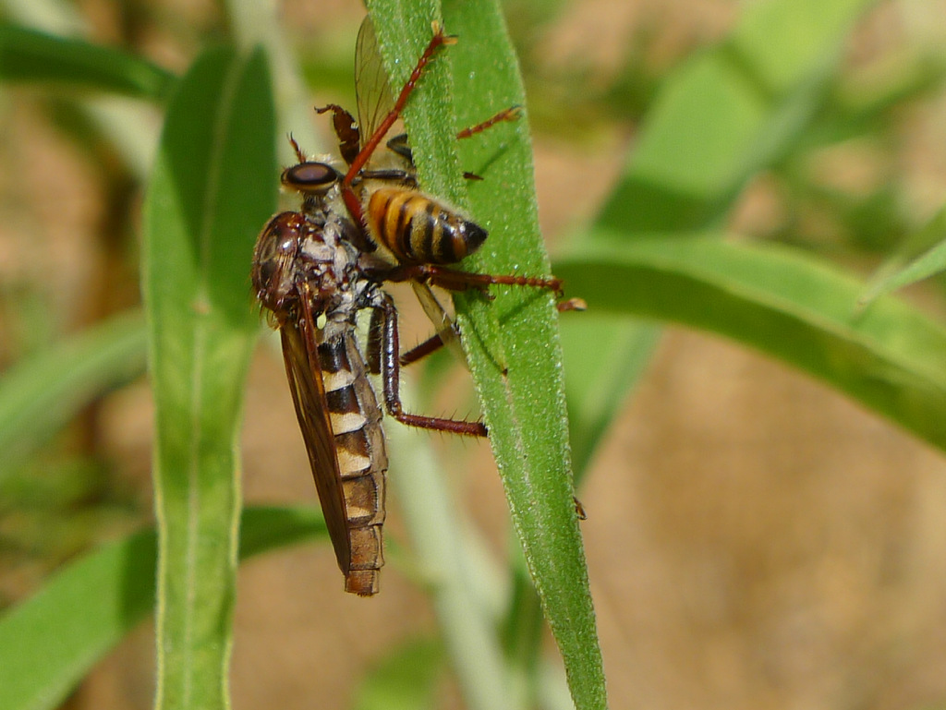Bees Inside A Fence
ByThe Natural Limiting Factors Of The Honey Bee Population
Limiting Factor: The Weather
The weather would be an obvious limiting factor—colonies are stressed by extreme cold, unfavorable flight weather during the spring or summer, or by lack of forage and water during droughts. Such intermittent weather events may sporadically cull the bee population, but would only affect long-term adaptation if they occurred regularly. So let’s focus upon which factors limited bee populations in favorable years, during which they have the intrinsic ability to increase exponentially.
Limiting Factor: Predation
Honey bees are herbivores. The populations of many herbivores are controlled by predators. If the population of the prey species becomes dense, predator species ramp up their numbers to take advantage of the food source. The result is typically an oscillating predator/prey population dynamic
Although predators of foraging bees may take a bite out of the population of older bees in the hive, they do not appear to be a primary limiting factor of the overall bee population. An exception to this rule might be the Asian Hornet, which can decimate small colonies of bees by picking off returning foragers.
A more serious form of predation is direct invasion of the hive. A healthy colony can generally repel or otherwise deal with small invaders such as ants, wasps, and Small Hive Beetles. More problematic are those large mammalian predators willing to ignore the bees’ defensive stinging, such as bears, skunks, honey badgers, and humans. The bees’ main defense against such predators is to nest in inaccessible fortifications.

Limiting Factor: Competition For Nest Cavities
Bees are pretty picky about the nest cavities that they choose, strongly preferring elevated tree cavities having small, defendable entrances. In treeless areas, the lack of suitable nest sites could well have been a limiting factor for the honey bee population. But this is unlikely to have been the primary limiting factor anywhere that patches of ancient forest were within range.
Although a lack of suitable cavities may not the main limiting factor of the bee population, it does bring to mind another fascinating aspect of bee behavior. Please allow me to digress for a bit. Not all beekeepers are aware that intra- and inter-species parasitism is common among bees, wasps, and ants. For example, queens of a number of bumblebee species parasitically invade and take over other bumblebee colonies. The Cape Bee is famous for its ability to parasitically take over colonies of the Savannah Bee.
Such takeovers give the usurping swarm a profound advantage. Rather than needing to establish a nest and provision it with stores from scratch, it can simply take over an established colony, essentially hijacking its combs, stores, and entire workforce. Bees typically swarm in spring, for the obvious reason that that timing allows the swarm colony to establish and provision a nest in time for winter. But in actuality, there are two peaks of swarming during a season

Limiting Factor: Carrying Capacity Of The Habitat
The maximum population density is set by the carrying capacity of that particular environment, typically limited by resources such as food. However, the honey bee is a special case; similar to the bear, the colony can gorge when food is plentiful, and store “fat” (honey and beebread) as reserves for lean times (as during overwintering).
There are indeed areas in which colonies can barely put on enough honey during the main flow in order to make it through the winter. But by definition, such areas would not meet a primary requirement of the fundamental of the honey bee, so we can disregard such areas from this discussion. What we are interested in is the limiting factor of the bee population in areas that normally produce a good honey flow.
Limiting Factor: The Timing Of The Bloom
Honey bees are defined by their ability to store food reserves—honey and beebread—to see them through lean times. But there are times other than the main honey flow during which the availability of nectar, and especially pollen, are of critical importance to the ability of colonies not only to survive, but also to reproduce. Colonies must build up and produce a swarm early enough in the season that both parent and swarm colony have fighting chances to store enough honey to make it through the following winter. Such buildup requires the initiation of brood rearing in the middle of winter, which is in turn dependent upon having stored a large supply of beebread during the fall pollen flow.
What we must keep in mind is that a colony of bees is only effective at putting away a honey surplus if it has grown a large enough population to efficiently forage upon and store the available nectar. Timing is everything. Too large a population at the wrong time of the year would be counterproductive, since those hungry mouths would consume more honey than they were able to store. A locally-adapted population of bees times its buildup to coincide with the main flow, and then quickly shrinks back to survival mode.
Bees adapted to colder winters, such as the Carniola’s or Russians, are far more responsive to the environment, especially to the availability of pollen. As soon as plants start producing pollen in spring, bees of these races explode into action —working even in cool and wet weather, and madly brood up.
So I suspect that the limiting factor for bees is not the amount of food available during a brief period of food abundance (the main honey flow), but rather the quality and quantity of forage available during spring and late summer/fall.
Limiting Factor: Competition For Those Food Resources
Competition for food resources, either against other species or one’s own species, is a common limiting factor. So what sort of competition do bees face?
Anywhere that there are flowering plants, there are pollinators that have coevolved with them. Most are insects (although in some areas, birds, bats, or other mammals may be important). Does competition with other pollinators limit the honey bee population?
Let’s think about it. Since one can place a hive of bees into most any favorable habitat and still make honey despite the presence of established populations of native pollinators, I suspect that competition with other species is not normally the limiting factor of the honey bee population. On the other hand, as any beekeeper quickly recognizes, honey bee colonies certainly compete with one another!
Beekeepers tend to focus upon the amount of nectar available during the main honey flow, and understand that one can overload an area with managed hives. But how about the density of a natural population of bees—does the amount of nectar available during the main flow limit that population?
Again, let’s check easy observations. In areas with well-established populations of feral bees (Australia, Hawaii, formerly in the U.S), one can bring in additional managed colonies, yet still produce a substantial honey crop during the main flow—clearly, nectar is produced in excess of what an established natural population of bees can harvest. It follows then that at a “normal” population density of unmanaged colonies, competition for nectar during the main flow was not the limiting factor for colony survival.
On the other hand, competition for pollen during spring or fall could well be a limiting factor. Along with that competition comes…
Limiting Factor: Intercolony Parasitism
Competition between colonies does not occur only for nest sites or at the flower; it can also happen directly at the hive. All’s fair in love, war, and in Nature. If you can save yourself effort by stealing the fruits of another’s labor, so be it. The term for this is kleptoparasitism (kleptoparasite: a bird, insect, or other animal that habitually robs animals of other species of food).
What we call “robbing” is a form of kleptoparasites, and during early spring or the summer dearth, the robbing pressure between colonies can brutal. There would be a clear competitive advantage to those colonies that successfully robbed honey from others; conversely, there would be an advantage to those colonies best able to defend their hard-won stores.

How are people harming pollinators?
Human beings have had a dramatic impact on the ecosystems of the earth, which directly affects many pollinator species.
Pesticides and Herbicides: Chemical pesticides and herbicides are causing big trouble for pollinators. These chemical innovations are designed to kill insects and plants that people don’t want around in their gardens, lawns, or farms. The problem is herbicides can also kill native plants and flowers that the pollinators need for energy, and both the pesticides and herbicides can get into the pollinators’ bodies, making them sick or killing them.
Loss of Habitat: People’s ability to transform landscapes from meadows and fields into cities, neighborhoods, and farmlands is disrupting natural habitats. The flowering plants, bushes and trees that pollinators rely on for both food and habitat are disappearing.
In conclusion…
My original question was what were the primary limiting factors in the realized niches of the honey bee prior to human influence? I hope that I have adequately covered these factors, since I feel that our understanding of them is critical for us to be better beekeepers, and to make good management decisions.
As always, I prefer to let the reader draw his/her own conclusions, but to me it appears that that the primary limiting factors in colony survival in favorable areas were most likely the density-dependent competition for pollen during spring and fall, coupled with the associated transmission of certain pathogens.
Leave a Reply